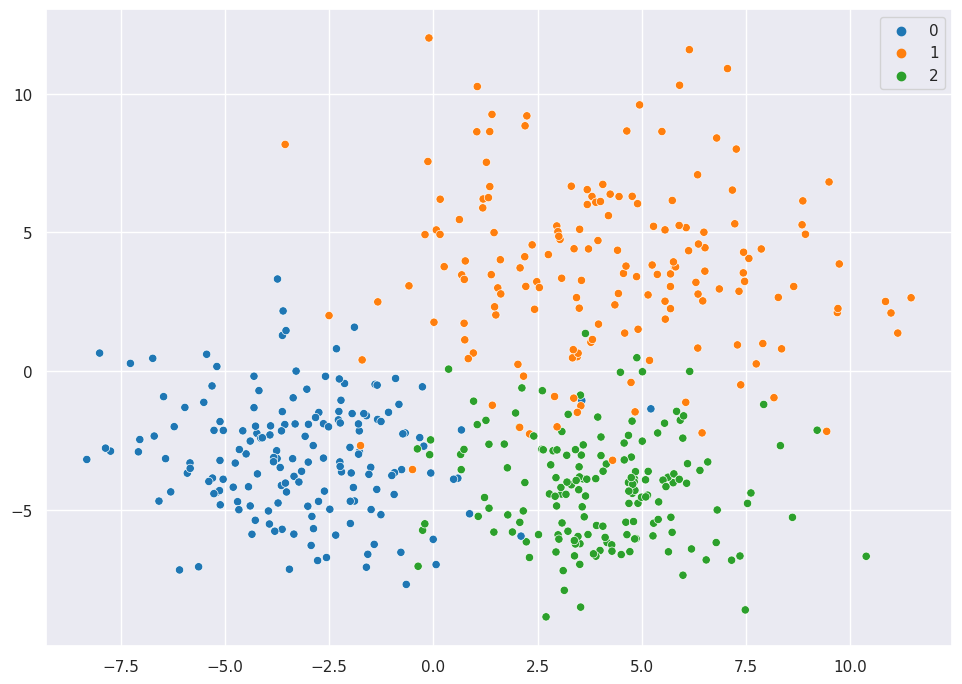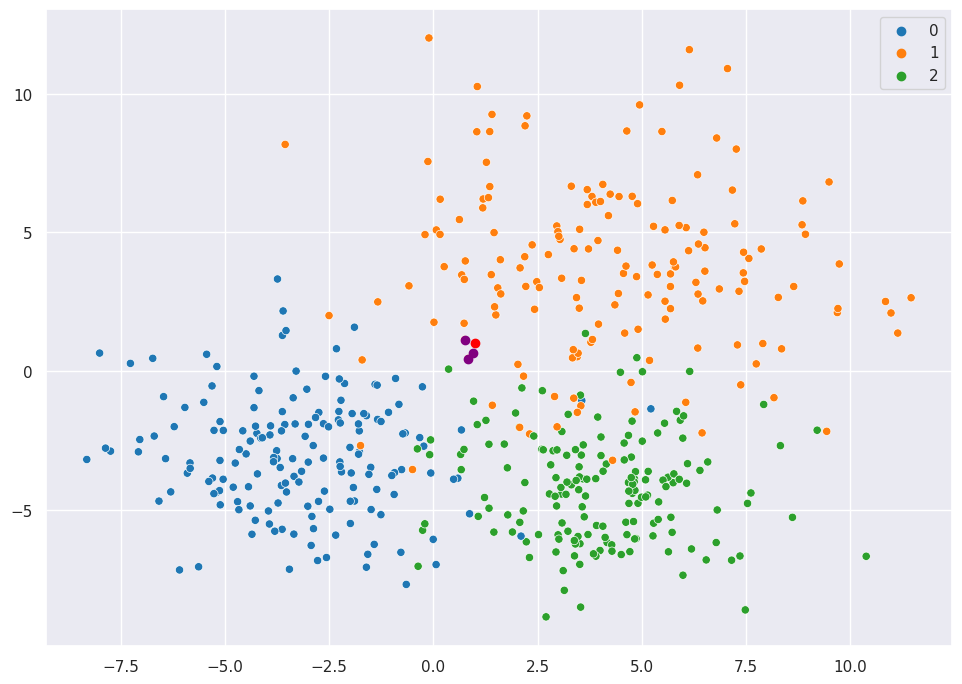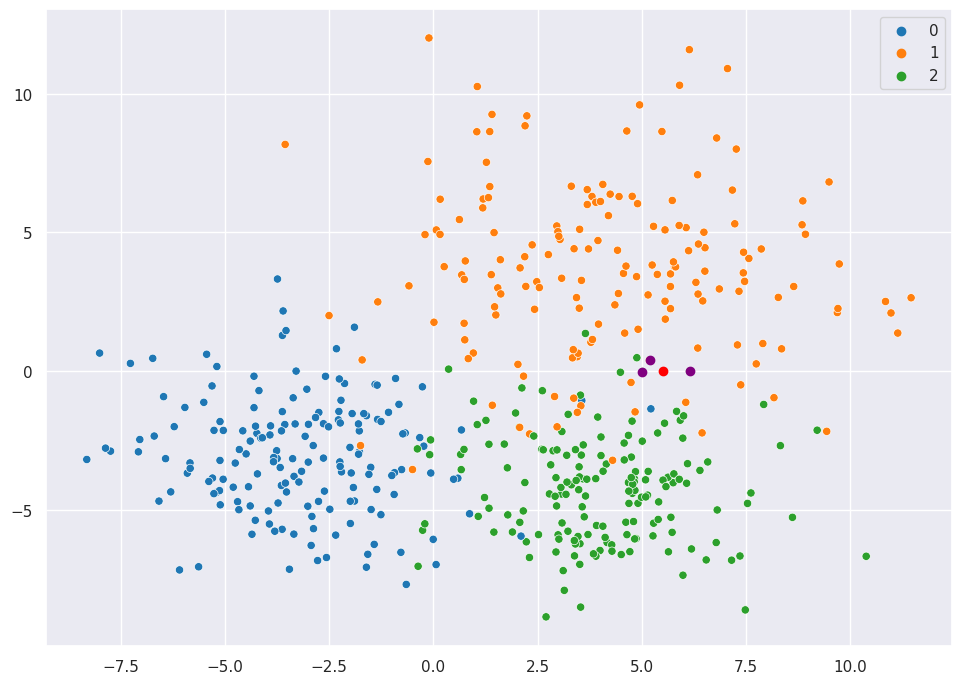K-Nearest Neighbors#
KNN is a supervised learning method.
Let k = 3. Given a test data point, identify the 3 (\(k\)) training data points that are closest, using some distance metric (e.g. Euclidean distance). Use a majority-wins rule to label the test data point. If using KNN for regression instead of classification, you might use the average of the k-nearest neighbors.
from sklearn.neighbors import KNeighborsClassifier
from sklearn.datasets import make_blobs
import pandas as pd
import numpy as np
import matplotlib.pyplot as plt
import seaborn as sns
sns.set(rc={'figure.figsize':(11.7,8.27)})
centers = [(-3, -3), (4, 4), (4, -4)]
cluster_std = [2, 3, 2]
X, y = make_blobs(
n_samples=500,
cluster_std = cluster_std,
centers = centers,
n_features = 2,
random_state=2
)
sns.scatterplot(X[:,0], X[:,1], hue=y, palette="tab10")
/home/chansoo/projects/statsbook/.venv/lib/python3.8/site-packages/seaborn/_decorators.py:36: FutureWarning: Pass the following variables as keyword args: x, y. From version 0.12, the only valid positional argument will be `data`, and passing other arguments without an explicit keyword will result in an error or misinterpretation.
warnings.warn(
<Axes: >

Using Sklearn#
neigh = KNeighborsClassifier(n_neighbors=3)
neigh.fit(X, y)
print(neigh.predict([[1, 1]]))
print(neigh.predict_proba([[1, 1]]))
[1]
[[0. 1. 0.]]
Things to Consider#
Parameter Selection: what “k” should you use? You can cross validate to optimize this hyperparameter
Balance: In the classification setting, majority-rules solution can be problematic if the distribution of classes is skewed. One way to address this would be to weight each training data point by the inverse of class proportion. Or you can construct a balanced training set
Distance: Euclidean distance is default, but other popular ones include: Minkowski, Manhattan Distance, Cosine Distance, Jaccard Distance, Hamming Distance
Weighting Neighbors: Given k nearest neighbors, some neighbors are closer than others. So you might let a vote = inverse of distance rather than letting all votes = 1. In general, we can let a vote = some function k(x, c) where x = obs and c = class albel. We call k(.) a kernel.
Local Sensitivity
Curse of High Dimensionality: key assumption of KNN is that similar inputs means same output. But as dimensions increase, inputs may never bee similar! One solution is to use a dimension-reduction method such as PCA to preprocess data.
Manually#
For a test point [1,1], identify 3 nearest neighbors.
test_point = np.array([1,1])
# euclidean distance between test point and all training points
dists = np.linalg.norm(X - test_point, axis=1)
# argpartition identifies kth element in array s.t. all smaller elements are
# moved before it and all larger elements are moved after it
ind = np.argpartition(dists, kth=3)[:3]
sns.scatterplot(X[:,0], X[:,1], hue=y, palette="tab10")
plt.scatter(test_point[0], test_point[1], c="red")
plt.scatter(X[ind,0], X[ind,1], c="purple")
/home/chansoo/projects/statsbook/.venv/lib/python3.8/site-packages/seaborn/_decorators.py:36: FutureWarning: Pass the following variables as keyword args: x, y. From version 0.12, the only valid positional argument will be `data`, and passing other arguments without an explicit keyword will result in an error or misinterpretation.
warnings.warn(
<matplotlib.collections.PathCollection at 0x7f22d18a4160>

their classes are all 1 so we would classify 1.
y[ind]
array([1, 1, 1])
For a test point [5,0], identify 3 nearest neighbors.
test_point = np.array([5.5,0])
dists = np.linalg.norm(X - test_point, axis=1)
ind = np.argpartition(dists, 3)[:3]
sns.scatterplot(X[:,0], X[:,1], hue=y, palette="tab10")
plt.scatter(test_point[0], test_point[1], c="red")
plt.scatter(X[ind,0], X[ind,1], c="purple")
/home/chansoo/projects/statsbook/.venv/lib/python3.8/site-packages/seaborn/_decorators.py:36: FutureWarning: Pass the following variables as keyword args: x, y. From version 0.12, the only valid positional argument will be `data`, and passing other arguments without an explicit keyword will result in an error or misinterpretation.
warnings.warn(
<matplotlib.collections.PathCollection at 0x7f22d181b1f0>

their classes are [2, 1, 1]; majority wins
y[ind]
array([1, 2, 2])